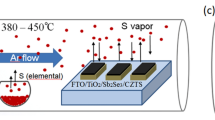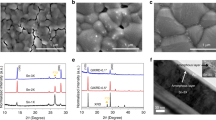Abstract
Electricity produced by cadmium telluride (CdTe) photovoltaic modules is the lowest-cost electricity in the solar industry, and now undercuts fossil fuel-based sources in many regions of the world. This is due to recent efficiency gains brought about by alloying selenium into the CdTe absorber, which has taken cell efficiency from 19.5% to its current record of 22.1%. Although the addition of selenium is known to reduce the bandgap of the absorber material, and hence increase the cell short-circuit current, this effect alone does not explain the performance improvement. Here, by means of cathodoluminescence and secondary ion mass spectrometry, we show that selenium enables higher luminescence efficiency and longer diffusion lengths in the alloyed material, indicating that selenium passivates critical defects in the bulk of the absorber layer. This passivation effect explains the record-breaking performance of selenium-alloyed CdTe devices, and provides a route for further efficiency improvement that can result in even lower costs for solar-generated electricity.
This is a preview of subscription content, access via your institution
Access options
Access Nature and 54 other Nature Portfolio journals
Get Nature+, our best-value online-access subscription
$29.99 / 30 days
cancel any time
Subscribe to this journal
Receive 12 digital issues and online access to articles
$119.00 per year
only $9.92 per issue
Buy this article
- Purchase on Springer Link
- Instant access to full article PDF
Prices may be subject to local taxes which are calculated during checkout




Similar content being viewed by others
Data availability
The data that support the plots within the paper and other findings of this study are available in the repository at Loughborough University (https://repository.lboro.ac.uk/) or from the corresponding author on reasonable request.
Change history
28 May 2019
An amendment to this paper has been published and can be accessed via a link at the top of the paper.
References
Gloeckler, M., Sankin, I. & Zhao, Z. CdTe solar cells at the threshold to 20% efficiency. IEEE J. Photovolt. 3, 1389–1393 (2013).
Green, M. A. et al. Solar cell efficiency tables (version 51). Prog. Photovolt. Res. Appl. 26, 3–12 (2018).
Lazard’s Levelized Cost of Energy Analysis—Version 11.0 (Lazard, 2017).
Balderelli, J. Public Utilities Commission of Nevada Electronic Filing (2015).
Hagenorf, C. et al. Assessment of Performance, Environmental, Health and Safety Aspects of First Solar’s CdTe Photovoltaic Technology (Cener, 2016).
Paudel, N. R. & Yan, Y. Enhancing the photo-currents of CdTe thin-film solar cells in both short and long wavelength regions. Appl. Phys. Lett. 105, 183510 (2014).
Swanson, D. E., Sites, J. R. & Sampath, W. S. Co-sublimation of CdSexTe1− x layers for CdTe solar cells. Sol. Ener. Mater. Sol. Cells 159, 389–394 (2017).
Poplawsky, J. D. et al. Structural and compositional dependence of the CdTexSe1−x alloy layer photoactivity in CdTe-based solar cells. Nat. Commun. 7, 12537 (2016).
Munshi, A. H. et al. Polycrystalline CdSeTe/CdTe absorber cells with 28 mA/cm2 short-circuit current. IEEE J. Photovolt. 8, 310–314 (2018).
Kephart, J. M. et al. Sputter-deposited oxides for interface passivation of CdTe photovoltaics. IEEE J. Photovoltaics 8, 587–593 (2018).
Kuciauskas, D. et al. Recombination velocity less than 100 cm/s at polycrystalline Al2O3/CdSeTe interfaces. Appl. Phys. Lett. 112, 263901 (2018).
Dharmadasa, I. Review of the CdCl2 treatment used in CdS/CdTe thin film solar cell development and new evidence towards improved understanding. Coatings 4, 282–307 (2014).
Barnard, E. S. et al. 3D lifetime tomography reveals how CdCl2 improves recombination throughout CdTe solar cells. Adv. Mater. 29, 1603801 (2017).
Fiducia, T. A. M. et al. 3D distributions of chlorine and sulphur impurities in a thin-film cadmium telluride solar cell. MRS Adv. 3, 3287–3292 (2018).
Abbas, A. et al. The effect of cadmium chloride treatment on close-spaced sublimated cadmium telluride thin-film solar cells. IEEE J. Photovolt. 3, 1361–1366 (2013).
Munshi, A. H. Polycrystalline CdTe photovolaics with efficiency over 18% through improved absorber passivation and current collection. Sol. Ener. Mater. Sol. Cells 176, 9–18 (2018).
Munshi, A. H. et al. Effect of CdCl2 passivation treatment on microstructure and performance of CdSeTe/CdTe thin-film photovoltaic devices. Sol. Ener. Mater. Sol. Cells 186, 259–265 (2018).
Harrison, L. G. Influence of dislocations on diffusion kinetics in solids with particular reference to the alkali halides. Trans. Faraday Soc. 57, 1191–1199 (1961).
Moutinho, H. R. et al. Grain boundary character and recombination properties in CdTe thin films. In 2013 IEEE 39th Photovoltaic Specialists Conference 3249–3254 (IEEE, 2013).
Moseley, J. et al. Cathodoluminescence analysis of grain boundaries and grain interiors in thin-film CdTe. IEEE J. Photovolt. 4, 1671–1679 (2014).
Moseley, J. et al. Recombination by grain-boundary type in CdTe. J. Appl. Phys. 118, 025702 (2015).
Stechmann, G. et al. A correlative investigation of grain boundary crystallography and electronic properties in CdTe thin film solar cells. Sol. Ener. Mater. Sol. Cells 166, 108–120 (2017).
Lane, D. W. A review of the optical band gap of thin film CdSxTe1−x. Sol. Ener. Mater. Sol. Cells 90, 1169–1175 (2006).
Mendis, B. G., Bowen, L. & Jiang, Q. Z. A contactless method for measuring the recombination velocity of an individual grain boundary in thin-film photovoltaics. Appl. Phys. Lett. 97, 092112 (2010).
Mendis, B. & Bowen, L. Cathodoluminescence measurement of grain boundary recombination velocity in vapour grown p-CdTe. J. Phys. Conf. Ser. 326, 012017 (2011).
Lee, J., Giles, N. C., Rajavel, D. & Summers, C. J. Room-temperature band-edge photoluminescence from cadmium telluride. Phys. Rev. B 49, 1668–1676 (1994).
Yang, J.-H., Yin, W.-J., Park, J.-S., Ma, J. & Wei, S.-H. Review on first-principles study of defect properties of CdTe as a solar cell absorber. Semicond. Sci. Technol. 31, 83002 (2016).
Yang, J. H., Shi, L., Wang, L. W. & Wei, S. H. Non-radiative carrier recombination enhanced by two-level process: a first-principles study. Sci. Rep. 6, 21712 (2016).
Abbas, A. The Microstructure of Thin Film Cadmium Telluride Photovoltaic Materials. PhD thesis, Loughborough Univ. (2014).
Acknowledgements
The authors at Loughborough University are grateful to the EPSRC CDT in New and Sustainable Photovoltaics for providing T.F. with a studentship, RCUK for providing funding through the EPSRC SUPERGEN SuperSolar Hub (EP/J017361/1), and the Loughborough Materials Characterisation Centre for use of equipment. The authors at Colorado State University acknowledge support from NSF AIR, NSF I/UCRC and DOE SIPS programmes. The work at Colorado State University was supported by NSF award 1540007, NSF PFI:AIR-RA programme 1538733 and DOE SIPS award DE-EE0008177. K.L. acknowledges support from EPSRC grant M018237/1.
Author information
Authors and Affiliations
Contributions
T.A.M.F. conceived this study and planned it along with J.M.W., K.L., C.R.M.G. and B.G.M. A.H.M. made the cells with assistance from K.B. and W.S.S. A.A. performed the TEM. T.A.M.F. prepared the samples for CL and SIMS characterization. B.G.M. carried out the CL measurements. K.L. performed the SIMS characterization with assistance from C.R.M.G. T.A.M.F. and L.D.W. performed the data analysis. T.A.M.F. wrote the manuscript with help from J.W.B. and J.M.W.
Corresponding author
Ethics declarations
Competing interests
The authors declare no competing interests.
Additional information
Publisher’s note: Springer Nature remains neutral with regard to jurisdictional claims in published maps and institutional affiliations.
Supplementary information
Supplementary Information
Supplementary Figs. 1–4
Rights and permissions
About this article
Cite this article
Fiducia, T.A.M., Mendis, B.G., Li, K. et al. Understanding the role of selenium in defect passivation for highly efficient selenium-alloyed cadmium telluride solar cells. Nat Energy 4, 504–511 (2019). https://doi.org/10.1038/s41560-019-0389-z
Received:
Accepted:
Published:
Issue Date:
DOI: https://doi.org/10.1038/s41560-019-0389-z
This article is cited by
-
From contaminant to commodity: a critical review of selenium usage, treatment, and recovery
Reviews in Environmental Science and Bio/Technology (2024)
-
Numerical modeling of the TiO2/CdS thin film solar cell and the role of CdSeXTe1−X layer in efficiency enhancement
Indian Journal of Physics (2024)
-
Highly Crystalline and Stoichiometric Growth of CdTe by Cost-Effective Hydrothermal Technique
Journal of Electronic Materials (2024)
-
Next-generation applications for integrated perovskite solar cells
Communications Materials (2023)
-
Single-source thermal evaporation converts anion controllable Sb2(S,Se)3 film for fabricating high-efficiency solar cell
Science China Materials (2023)



